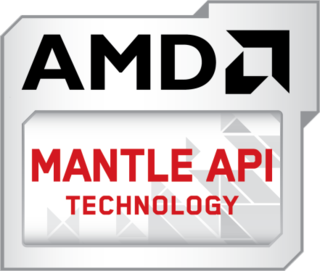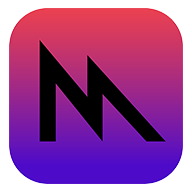Related Research Articles

OpenGL is a cross-language, cross-platform application programming interface (API) for rendering 2D and 3D vector graphics. The API is typically used to interact with a graphics processing unit (GPU), to achieve hardware-accelerated rendering.
Gecko is a browser engine developed by Mozilla. It is used in the Firefox browser, the Thunderbird email client, and many other projects.

In computer graphics, a shader is a computer program that calculates the appropriate levels of light, darkness, and color during the rendering of a 3D scene—a process known as shading. Shaders have evolved to perform a variety of specialized functions in computer graphics special effects and video post-processing, as well as general-purpose computing on graphics processing units.

OpenGL for Embedded Systems is a subset of the OpenGL computer graphics rendering application programming interface (API) for rendering 2D and 3D computer graphics such as those used by video games, typically hardware-accelerated using a graphics processing unit (GPU). It is designed for embedded systems like smartphones, tablet computers, video game consoles and PDAs. OpenGL ES is the "most widely deployed 3D graphics API in history".
Mesa, also called Mesa3D and The Mesa 3D Graphics Library, is an open source implementation of OpenGL, Vulkan, and other graphics API specifications. Mesa translates these specifications to vendor-specific graphics hardware drivers.
A shading language is a graphics programming language adapted to programming shader effects. Shading languages usually consist of special data types like "vector", "matrix", "color" and "normal".

OpenGL Shading Language (GLSL) is a high-level shading language with a syntax based on the C programming language. It was created by the OpenGL ARB to give developers more direct control of the graphics pipeline without having to use ARB assembly language or hardware-specific languages.
A browser extension is a software module for customizing a web browser. Browsers typically allow users to install a variety of extensions, including user interface modifications, cookie management, ad blocking, and the custom scripting and styling of web pages.
Adreno is a series of graphics processing unit (GPU) semiconductor intellectual property cores developed by Qualcomm and used in many of their SoCs.
Web3D, also called 3D Web, is a group of technologies to display and navigate websites using 3D computer graphics.
Direct2D is a 2D vector graphics application programming interface (API) designed by Microsoft and implemented in Windows 10, Windows 8, Windows 7 and Windows Server 2008 R2, and also Windows Vista and Windows Server 2008.

The Skia Graphics Engine or Skia is an open-source 2D graphics library written in C++. Skia abstracts away platform-specific graphics APIs. Skia Inc. originally developed the library; Google acquired it in 2005, and then released the software as open source licensed under the New BSD free software license in 2008.

WebGL is a JavaScript API for rendering interactive 2D and 3D graphics within any compatible web browser without the use of plug-ins. WebGL is fully integrated with other web standards, allowing GPU-accelerated usage of physics, image processing, and effects in the HTML canvas. WebGL elements can be mixed with other HTML elements and composited with other parts of the page or page background.
HTML5 Audio is a subject of the HTML5 specification, incorporating audio input, playback, and synthesis, as well as in the browser. iOS

Mantle was a low-overhead rendering API targeted at 3D video games. AMD originally developed Mantle in cooperation with DICE, starting in 2013. Mantle was designed as an alternative to Direct3D and OpenGL, primarily for use on personal computers, although Mantle supports the GPUs present in the PlayStation 4 and in the Xbox One. In 2015, Mantle's public development was suspended and in 2019 completely discontinued, as DirectX 12 and the Mantle-derived Vulkan rose in popularity.
ANGLE is an open source, cross-platform graphics engine abstraction layer developed by Google. ANGLE translates OpenGL ES 2/3 calls to DirectX 9, 11, OpenGL or Vulkan API calls. It's a portable version of OpenGL but with limitations of OpenGL ES standard.

Metal is a low-level, low-overhead hardware-accelerated 3D graphic and compute shader API created by Apple, debuting in iOS 8. Metal combines functions similar to OpenGL and OpenCL in one API. It is intended to improve performance by offering low-level access to the GPU hardware for apps on iOS, iPadOS, macOS, and tvOS. It can be compared to low-level APIs on other platforms such as Vulkan and DirectX 12.
Vulkan is a low-level low-overhead, cross-platform API and open standard for 3D graphics and computing. It was intended to address the shortcomings of OpenGL, and allow developers more control over the GPU. It is designed to support a wide variety of GPUs, CPUs and operating systems, it is also designed to work with modern multi-core CPUs.
WebXR Device API is a Web application programming interface (API) that describes support for accessing augmented reality and virtual reality devices, such as the HTC Vive, Oculus Rift, Oculus Quest, Google Cardboard, HoloLens, Apple Vision Pro, Magic Leap or Open Source Virtual Reality (OSVR), in a web browser. The WebXR Device API and related APIs are standards defined by W3C groups, the Immersive Web Community Group and Immersive Web Working Group. While the Community Group works on the proposals in the incubation period, the Working Group defines the final web specifications to be implemented by the browsers.
References
- 1 2 3 "Chrome ships WebGPU". Chrome Developers. Retrieved 2023-04-08.
- 1 2 3 4 "WebGPU Implementation Status". GitHub. Retrieved 14 March 2024.
- ↑ "WebGPU API". developer.mozilla.org. Retrieved 17 March 2024.
- ↑ WebGPU Shading Language specification
- ↑ Tint source code
- ↑ Naga source code
- ↑ wgpu, Rust Graphics Mages, 2024-01-03, retrieved 2024-01-03
- ↑ Wallez, Corentin. "Explicit web graphics API" . Retrieved 2019-06-25.
- ↑ Wallez, Corentin; Ninomiya, Kai. "WebGL Next investigations" . Retrieved 2019-06-25.
- ↑ "Next-generation 3D Graphics on the Web". WebKit. 2017-02-07. Retrieved 2018-08-13.
- ↑ "Apple seeks to position Metal as part of new 3D graphics standard for web". AppleInsider. Retrieved 2018-08-13.
- ↑ Claburn, Thomas (2017-02-08). "Web-standards-allergic Apple unveils WebGPU, a web graphics standard". The Register . Retrieved 2017-08-14.
- 1 2 Wallez, Corentin (2018-05-31). "Intent to Implement: WebGPU". blink-dev (Mailing list). Retrieved 2018-08-13.
- ↑ "WebGPU Prototype and Demos". WebKit. 2017-04-05. Retrieved 2019-01-10.
- ↑ Jackson, Dean (2017-02-16). "Welcome and Getting Started". public-gpu (Mailing list). Retrieved 2018-09-11.
- ↑ Jackson, Dean. "Add Apple's WebGPU proposal". GitHub . Retrieved 2019-03-08.
- ↑ Malyshau, Dzmitry. "Prototyping a new 3D API for the Web" . Retrieved 2016-12-16.
- ↑ Malyshau, Dzmitry (2017-03-21). "Defining the Web platform" . Retrieved 2018-09-11.
- ↑ Malyshau, Dzmitry. "Mozilla's contribution: Obsidian API". GitHub . Retrieved 2019-03-08.